The Georgia Northeastern Railroad is a short line freight railroad which runs from the town of Elizabeth, Georgia to the city of Blue Ridge, Georgia. Goods hauled are mostly timber, grain, poultry, and marble products. The GNRR's subsidiary, the Blue Ridge Scenic Railway, also operates on this line north of Blue Ridge. Despite the name, it actually operates between north-central and northwest Georgia, from north-northwest metro Atlanta, and is a few counties away from northeast Georgia.

Saint Paul Union Depot is a historic railroad station and intermodal transit hub in the Lowertown neighborhood of the city of Saint Paul, Minnesota, United States. It serves light rail, intercity rail, intercity bus, and local bus services.
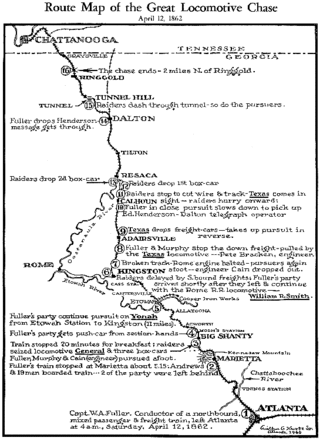
The Western & Atlantic Railroad of the State of Georgia (W&A) is a railroad owned by the State of Georgia and currently leased by CSX, which CSX operates in the Southeastern United States from Atlanta, Georgia, to Chattanooga, Tennessee.

The Great Locomotive Chase was a military raid that occurred April 12, 1862, in northern Georgia during the American Civil War. Volunteers from the Union Army, led by civilian scout James J. Andrews, commandeered a train, The General, and took it northward toward Chattanooga, Tennessee, doing as much damage as possible to the vital Western and Atlantic Railroad (W&A) line from Atlanta to Chattanooga as they went. They were pursued by Confederate forces at first on foot, and later on a succession of locomotives, including The Texas, for 87 miles (140 km).

Atlanta History Center is a history museum and research center located in the Buckhead district of Atlanta, Georgia. The Museum was founded in 1926 and currently consists of nine permanent, and several temporary, exhibitions. Atlanta History Center's campus is 33-acres and features historic gardens and houses located on the grounds, including Swan House, Smith Farm, and Wood Family Cabin. Atlanta History Center's Midtown Campus includes the Margaret Mitchell House & Museum. The History Center's research arm, Kenan Research Center, is open by appointment, and provides access to the archival collections. Atlanta History Center holds one of the largest collections of Civil War artifacts in the United States.
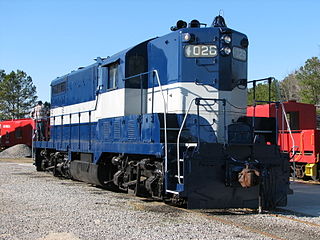
The Georgia Railroad and Banking Company also seen as "GARR", was a historic railroad and banking company that operated in the U.S. state of Georgia. In 1967 it reported 833 million revenue-ton-miles of freight and 3 million passenger-miles; at the end of the year it operated 331 miles (533 km) of road and 510 miles (820 km) of track.

The Atlanta and West Point Rail Road was a railroad in the U.S. state of Georgia, forming the east portion of the Atlanta-Selma West Point Route. The company was chartered in 1847 as the Atlanta and LaGrange Rail Road and renamed in 1857; construction of the 5 ft gauge line was begun in 1849-50 and completed in May 1854. A large minority interest owned by the Georgia Railroad and Banking Company eventually passed under the control of the Atlantic Coast Line Railroad (ACL), which later acquired a majority of the stock.

The Central of Georgia Railway started as the Central Rail Road and Canal Company in 1833. As a way to better attract investment capital, the railroad changed its name to Central Rail Road and Banking Company of Georgia. This railroad was constructed to join the Macon and Western Railroad at Macon, Georgia, in the United States, and run to Savannah. This created a rail link from Chattanooga, on the Tennessee River, to seaports on the Atlantic Ocean. It took from 1837 to 1843 to build the railroad from Savannah to the eastern bank of the Ocmulgee River at Macon; a bridge into the city was not built until 1851.

The Washington and Old Dominion Railroad was an intrastate short-line railroad located in Northern Virginia, United States. The railroad was a successor to the bankrupt Washington and Old Dominion Railway and to several earlier railroads, the first of which began operating in 1859. The railroad closed in 1968.

The Atlanta, Birmingham and Coast Railroad was organized in 1926 to replace the bankrupt Atlanta, Birmingham and Atlantic Railway. The AB&C was controlled by the Atlantic Coast Line Railroad, which owned a majority of the stock. In 1944 it reported 763 million net ton-miles of revenue freight and 33 million passenger-miles; at the end of that year it operated 639 miles of road and 836 miles of track.
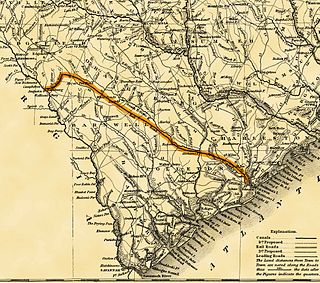
The South Carolina Canal and Rail Road Company was a railroad in South Carolina that operated independently from 1830 to 1844. One of the first railroads in North America to be chartered and constructed, it provided the first steam-powered, scheduled passenger train service in the United States.

Downtown Atlanta is the central business district of Atlanta, Georgia, United States. The larger of the city's two other commercial districts, it is the location of many corporate and regional headquarters; city, county, state, and federal government facilities; Georgia State University; sporting venues; and most of Atlanta's tourist attractions. It measures approximately four square miles, and had 26.850 residents as of 2017. Similar to other central business districts in the United States, it has recently undergone a transformation that includes the construction of new condos and lofts, renovation of historic buildings, and arrival of new residents and businesses.

William Allen Fuller was a conductor on the Western & Atlantic Railroad during the American Civil War era. He was most noted for his role in the 1862 Great Locomotive Chase, a daring sabotage mission and raid conducted by soldiers of the Union Army in northern Georgia. Fuller's determined pursuit prevented the Union agents from driving a captured train north to Tennessee and the Union lines.

Western & Atlantic Railroad #49 "Texas" is a 4-4-0 "American" type steam locomotive built in 1856 for the Western & Atlantic Railroad by Danforth, Cooke & Co., best known as the principal pursuit engine in the Great Locomotive Chase, chasing the General after the latter was stolen by Union saboteurs in an attempt to ruin the Confederate rail system during the American Civil War. The locomotive is preserved at the Atlanta History Center.
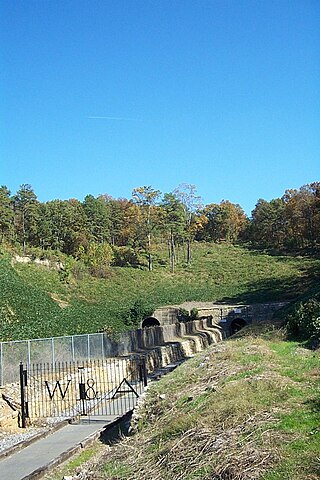
The Chetoogeta Mountain Tunnel refers to two different railroad tunnels passing through Chetoogeta Mountain in Tunnel Hill, Georgia, United States.

The Atlanta Constitution Building, also known as the Georgia Power Atlanta Division Building, is located at the northwest corner of Alabama and Forsyth Streets in downtown Atlanta, Georgia, at 143 Alabama Street, SW. It is located in an area known as the "Heart of Atlanta" straddling the railroad gulch, "due to [its] proximity to the 'Zero Mile Post' which marked both the Southeastern terminus of the Western and Atlantic railroad and the city's earliest settlement". The former Atlanta Constitution Building was designed by Adolph Wittman and was located at the opposite corner of the intersection beginning in 1895.
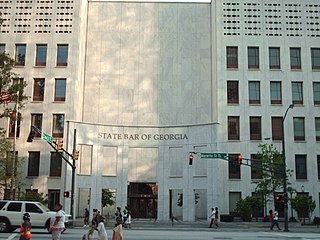
The State Bar of Georgia Building is located at 104 Marietta St. NW in Downtown Atlanta. The building opened in 1918, and was designed by A. Ten Eyck Brown, one of the most notable architects of public buildings in Atlanta in the first third of the 20th century. It was originally occupied by the Federal Reserve Bank of Atlanta before the bank moved to Midtown Atlanta in 2001 and is now occupied by the State Bar of Georgia.

The Western and Atlantic Depot is a historic Western and Atlantic Railroad train depot in Dalton, Georgia. It was built in 1852 in the Greek Revival style. The building is the oldest surviving commercial structure in Dalton and is a "fine example" of depot architecture in Georgia in the mid-1800s. It served as both a freight and passenger station.
Chattanooga Union Station, more commonly known as the Union Depot in Chattanooga, constructed between 1857-1859, served as a train car shed in Chattanooga, Tennessee. Located at Broad and Ninth Streets, the station was one of two major railroad terminals in the city, the other being the Southern Railway's Terminal Station.
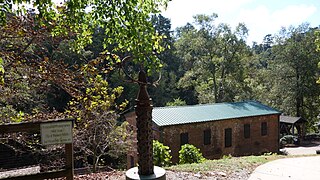
The Roswell Historic District, in Roswell, Georgia in Fulton County, was listed on the National Register of Historic Places in 1974.





















